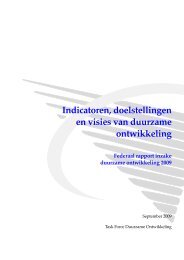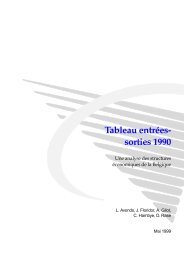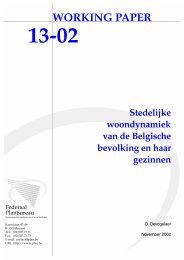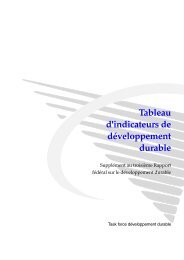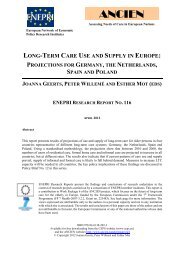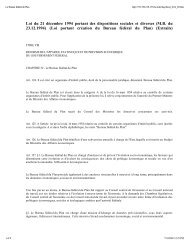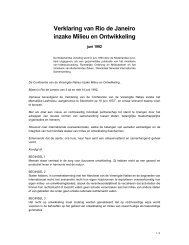<strong>LIAM</strong> 2 <strong>User</strong> <strong>Guide</strong>, Release 0.7.0collar_process:- no_collar: WORKING and collar == -1- collar: if(no_collar and (education_level == 2),if(gender,choice([1, 2], [0.836, 0.164]),choice([1, 2], [0.687, 0.313]) ),collar)- collar: if(no_collar and (education_level == 3),if(gender,choice([1, 2], [0.643, 1 - 0.643]),choice([1, 2], [0.313, 1 - 0.313]) ),collar)- collar: if(no_collar and (education_level == 4),if(gender,choice([1, 2], [0.082, 1 - 0.082]),choice([1, 2], [0.039, 1 - 0.039]) ),collar)The procedure collar_process has collar as the key endogenous variable and has four sub-processes.The first sub-process defines a local variable no_collar, which will be used to select those that the procedure shouldapply to. These are all the workers that do not have a value for collar.The next three sub-processes simulate the actual collar variable. If one meets the above no_collar filter and hasthe lowest level of education (2), then one has a probability of about 83.6% (men) and 68.7% (women) of being ablue collar worker. If one has “education_level” equal to 3, the probability of being a blue collar worker is lower(64.3% for men and 31.3% for women), etc.5.5.8 Regressionslogit_scoreThe logit of a number p between 0 and 1 is given by the formula:logit(p) = log(p / (1 - p))Its inverse, the logistic function has the interesting property that it can convert any real number into a probability.logistic(a) = 1 / (1 + exp(-a))The logit_score function is a logistic with a random part:logit_score(a) = logistic(a - logit(u))where u is a random number from an uniform distribution [0, 1).logit_score is very useful in behavioural equations. A behavioural equation starts by creating a score that reflectsthe risk p*i of an event occuring. A typical usage is as follow:- score_variable: if(condition_1,logit_score(logit_expr_1),if(condition_2,logit_score(logit_expr_2),-1))However, the nested structure can make things less readable if you have many different conditions. In that case,one would prefer the following longer form:process_name:# initialise the score to -1- score_variable: -1# first condition20 Chapter 5. Processes
<strong>LIAM</strong> 2 <strong>User</strong> <strong>Guide</strong>, Release 0.7.0- score_variable: if(condition_1,logit_score(logit_expr_1),score_variable)# second condition- score_variable: if(condition_2,logit_score(logit_expr_2),score_variable)# ... other conditions ...In a first sub-process, a variable score_variable is set equal to -1, because this makes it highly unlikely that theevent will happen to those not included in the conditions for which the logit is applied.Next, subject to conditions condition_1 and condition_2, this score (risk) is simulated on the basis of estimatedlogits. Note that by specifying the endogenous variable score_variable without any transformation in the “else”conditions of the if functions makes sure that the score variable is not manipulated by a sub-process it does notpertain to.When the score is known, it can be either used as-is:- event_happened: uniform() < score_variableor in combination with an alignment (see below).alignNow that we have computed a score (risk) for an event happening, we might want to use alignment so the numberof events occuring per category matches a proportion defined externaly.There are different ways to choose which individuals are taken. The methodology used for now by <strong>LIAM</strong> 2 iscalled “alignment by sorting”, that is, for each category, the N individuals with the highest scores are selected.The score computation is not done internally by the align() function, but is rather computed by an expressiongiven by the modeller. One will usually use logit_score() to compute it, but it can be computed in any other way amodeller choose.To know more about the alignment process reading “Evaluating Alignment Methods in Dynamic MicrosimulationModels”, by Li and O’Donoghue is advised.An alignment expression takes the following general form:align(score,proportions[, filter=conditions][, take=conditions][, leave=conditions][, expressions=expressions][, possible_values=pvalues][, frac_need="uniform"|"round"|"cutoff"])For example, it could look like:- unemp: align(unemp_score,’al_p_unemployed_m.csv’,filter=not ISINWORK and (age > 15) and (age < 65),take=ISUNEMPLOYED,leave=ISSTUDENT or ISRETIRED)Now let us examine each argument in turn:• score: it must be an expression (or a simple variable) returning a numerical value. It will be used to rankindividuals. One will usually use logit_score() to compute the score, but it can be computed in any otherway a modeller choose. Note that the score is not modified in any way within the align() function, so if one5.5. Expressions 21
- Page 3: CONTENTS1 Introduction 11.1 About L
- Page 6: LIAM 2 User Guide, Release 0.7.0Mor
- Page 9 and 10: CHAPTERTHREEMODEL DEFINITIONTo defi
- Page 11: LIAM 2 User Guide, Release 0.7.0•
- Page 16 and 17: LIAM 2 User Guide, Release 0.7.012
- Page 20 and 21: LIAM 2 User Guide, Release 0.7.0•
- Page 22 and 23: LIAM 2 User Guide, Release 0.7.0mac
- Page 26 and 27: LIAM 2 User Guide, Release 0.7.0wan
- Page 28 and 29: LIAM 2 User Guide, Release 0.7.0- w
- Page 30 and 31: LIAM 2 User Guide, Release 0.7.0oth
- Page 32 and 33: LIAM 2 User Guide, Release 0.7.0reg
- Page 34 and 35: LIAM 2 User Guide, Release 0.7.0‘
- Page 36 and 37: LIAM 2 User Guide, Release 0.7.0gen
- Page 38 and 39: LIAM 2 User Guide, Release 0.7.0You
- Page 40 and 41: LIAM 2 User Guide, Release 0.7.0As
- Page 42 and 43: LIAM 2 User Guide, Release 0.7.038
- Page 44: LIAM 2 User Guide, Release 0.7.0pro
- Page 47 and 48: LIAM 2 User Guide, Release 0.7.0# i
- Page 49 and 50: LIAM 2 User Guide, Release 0.7.0civ
- Page 51 and 52: CHAPTERNINEINDICES AND TABLES• ge
- Page 53 and 54: CHAPTERTENAPPENDIX10.1 Known issues
- Page 55 and 56: LIAM 2 User Guide, Release 0.7.0The
- Page 57 and 58: LIAM 2 User Guide, Release 0.7.0mai
- Page 59 and 60: LIAM 2 User Guide, Release 0.7.0mai
- Page 61 and 62: LIAM 2 User Guide, Release 0.7.0- n
- Page 63 and 64: LIAM 2 User Guide, Release 0.7.0•
- Page 65 and 66: LIAM 2 User Guide, Release 0.7.0•
- Page 67 and 68: LIAM 2 User Guide, Release 0.7.0•
- Page 69 and 70: LIAM 2 User Guide, Release 0.7.0Fix
- Page 71 and 72: LIAM 2 User Guide, Release 0.7.010.
- Page 73: INDEXaggregate functions, 17align,




